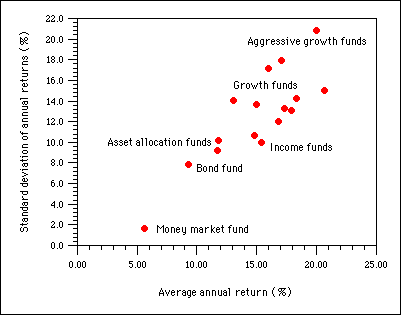The Retirement Income Simulation Spreadsheet
http://www.wam.umd.edu/~toh/income/Tom O'Haver, University of Maryland, April 1998. Revised April, 2008.
Swedish translation by Weronika Pawlak. Dutch translation by Johanne Teerink.
This simulation shows how much income you can withdraw from a retirement account of (e.g. an IRA or 401k account) that is invested it in a combination of fixed-interest or variable (equity) instruments, assuming that all interest and capital gains are re-invested and not taxed. You can control the income withdrawn, the return on the fixed-income and equity portions of your investments, and the volatility (uncertainty) of the equity portion. Graphs show the variation of principal and monthly income vs time for a 35-year period of retirement (for example, from age 65 to 100, or from age 60 to 95). (A companion simulation, the Investment Simulation Spreadsheet can be used to estimate the principal that can be accumulated by investing in your working years). Instructions and further explanation is available on https://terpconnect.umd.edu/~toh/simulations/Instructions.html
Note: This simulation was developed for instructional purposes and is not intended a tool for detailed personal financial planning. It does not take into account certain personal and legal factors that may apply to citizens of the USA, such as: additional income from pensions, Social Security, or wage earnings; income taxes and capital gains taxes; IRS penalties for early withdrawal before age 59 or for excess withdrawls above $150,000 per year; and IRS minimum required withdrawls from tax-deferred accounts after age 70 1/2.
This simulation is available in three different spreadsheet formats:
The Microsoft Excel version is in Excel 97/2000/XP format. You must own Excel or Microsoft Office in order to run this version.
The original WingZ version is still available. This version uses mouse-controlled sliders for input control and was developed using WingZ 1.1, an object-oriented spreadsheet for Windows, Macintosh, and UNIX. You must own a copy of WingZ 1.1 to run this version. You may download this version of the simulation in binary or HQX format.
The Inputs:
You can simulate the effect of these fluctuations by setting the "Volatility" variable to some non-zero value. Doing so will introduce some "bumpiness" in the principal curve (and in the income curve, if you are basing all or some of your income on a percentage of principal). Every time you recalculate the spreadsheet, another random set of returns is calculated. This is like simulating various alternative possible "futures". Every time you try out a different set of input variables, you should press F9 several time to observe how much your income varies.
An obvious effect of fluctuation in investment returns is that it makes precise planning impossible. In fact, the effect of fluctuation is greater in your retirement years, when you are withdrawing income from your retirement accounts, than in your wealth-accumulation years, when you are contributing to to your retirement accounts. This is illustrated in the following graph, which shows a simulation of random fluctuating returns on investment principal for two scenarios. The top graph illustrates the wealth-accumulation years (calculated with the Investment Simulation Spreadsheet) and the bottom graph illustrates the retirement income years. The average annual return (10%) and standard deviation (15%) are identical for these two scenarios. The only difference is that in the top graph, regular contributions are made, while in the bottom graph, regular withdrawls are made. Clearly, the effect of volatility is much greater in the retirement income. This is one reason that retired persons are often advised to keep their principal invested in a balanced portfolio of conservative equity funds and fixed-return funds, in order to reduce volatility. People in their wealth-accumulation investment phase, however, can tolerate more volatility and can afford to invest more aggressively.

But there is another and even more serious problem. If the standard deviation is suficiently large relative to the average return, it is possible that your principal may be exhausted within your life expectancy. Once that happens, there is no way to recover your principal, because you are no longer making contributions. Try increasing the volatility and see if you can observe such a "go broke" scenario. Obviously, you want to eliminate this possiblity. There are several ways to reduce the likelyhood of going broke: you could reduce your rate of withdrawls, increase the rate of return on your investments, or reduce the volatility of your investment returns.

You can simulate the effect of investing in these types of funds by using these values to set the "Equity Return" and "Volatility" variables. (In the WingZ version, full-scale on the Volatility slider represents a standard deviation of 60%. The standard deviation is displayed at the top right of the slider). Question: based on the mutual fund data list in this table, which of these fund types would allow the greatest annual income to be withdrawn without significant risk of going broke before year 35?
Despite the greater risk of equities compared to fixed-return investments, the long-term average return is still better for equities. Life expectances are now long enough that many of us will spend 30 years or more in retirement, which most people would consider a long-term investment. For this reason many retired people keep a substantial fraction of their principal invested in equities.